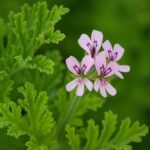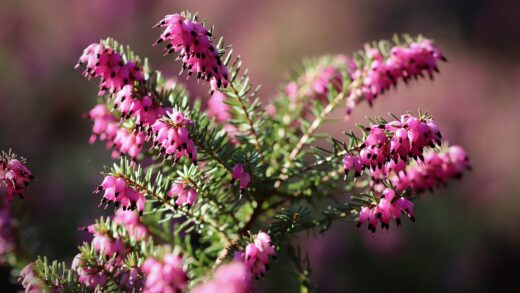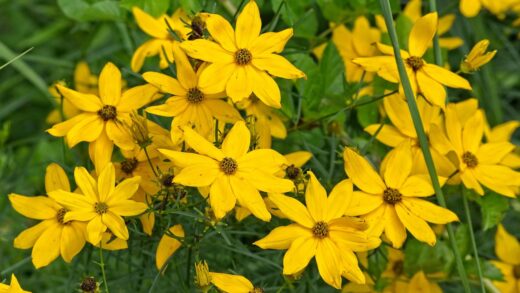While Lithodora diffusa is a relatively robust and trouble-free plant when its specific cultural requirements are met, it is not entirely immune to problems. Like any plant, it can fall victim to certain diseases and pests, particularly when it is weakened by stress from poor growing conditions. The vast majority of issues that arise with this vibrant ground cover are directly linked to its two most critical needs: acidic soil and excellent drainage. Failure to provide these foundational elements creates a stressed plant that is far more susceptible to attack. Therefore, the most effective strategy for disease and pest management is not reactive treatment, but proactive prevention through the creation of an ideal growing environment where the plant can thrive and naturally fend off most threats.
The most significant and deadly threat to Lithodora is not a pest or a typical foliar disease, but rather a soil-borne pathogen that causes root rot. This issue is almost invariably the result of the plant being situated in soil that is too heavy, compacted, or waterlogged. When the roots are deprived of oxygen in saturated soil, they become vulnerable to water moulds like Phytophthora. These pathogens attack the root system, causing it to decay and lose its ability to function. The consequences are dire and often irreversible, making the prevention of waterlogged conditions the number one priority for any gardener growing this plant.
Foliar diseases, while generally less common and less fatal than root rot, can occasionally make an appearance, especially during periods of high humidity or prolonged wet weather. Fungal issues such as botrytis (grey mould) or powdery mildew can develop on the dense mat of foliage where air circulation is poor. These diseases are often opportunistic, taking hold on plants that are already under stress or in locations that do not provide adequate airflow. While they may mar the plant’s appearance, they are usually not life-threatening if addressed promptly through cultural practices like improving air circulation and avoiding overhead watering.
Pests are rarely a major concern for Lithodora diffusa, as its slightly hairy leaves seem to be unpalatable to many common garden marauders. However, no plant is completely pest-proof, and occasional infestations can occur. Sap-sucking insects such as aphids may sometimes colonize the tender new growth, particularly in the spring. Slugs and snails might also cause some minor damage to the foliage, especially in damp, shaded conditions. In most cases, these pest problems are minor and can be managed with simple, non-chemical methods without resorting to harsh pesticides.
The primary threat: root rot
Root rot is the most serious and prevalent disease to affect Lithodora diffusa, and it is almost exclusively a man-made problem resulting from improper site and soil conditions. The culprit is typically a soil-borne water mould, a fungus-like organism from the Phytophthora or Pythium genus, which thrives in poorly drained, anaerobic soils. When the soil remains saturated for extended periods, these pathogens proliferate and attack the plant’s fine, sensitive root system. The infection causes the roots to turn brown, mushy, and decay, completely destroying their ability to absorb the water and nutrients essential for the plant’s survival.
More articles on this topic
The above-ground symptoms of root rot can be distressingly misleading, as they often mimic the signs of drought stress. An affected plant will typically exhibit wilting, yellowing leaves (chlorosis), and a general lack of vigor, which might prompt a well-meaning gardener to provide more water, thus worsening the situation. One key difference is that the wilting caused by root rot will not improve after watering. As the disease progresses, entire sections of the plant may turn brown and die back, and in advanced cases, the entire plant will perish. By the time these symptoms are obvious, the damage to the root system is usually extensive and irreversible.
Prevention is the only effective strategy for dealing with root rot, as there is no reliable cure once an infection has taken hold. The entire prevention strategy revolves around providing exceptionally sharp drainage. This begins with selecting an appropriate site, such as a slope or a raised bed, and thoroughly amending the soil before planting. Incorporating generous amounts of horticultural grit, coarse sand, or perlite is essential to create a porous structure that allows excess water to drain away freely and enables oxygen to reach the roots. For gardeners with heavy clay soil, planting in containers with a custom, gritty potting mix is often the safest and most successful option.
Careful watering practices are also a critical component of prevention. It is vital to allow the soil to dry out to some extent between waterings and to avoid a constantly saturated state. Watering deeply but infrequently is a much better approach than light, frequent sprinkling. Always check the soil moisture before watering, and if in doubt, it is always safer to wait another day. By focusing on creating the right soil environment from the outset and practicing mindful irrigation, you can almost completely eliminate the threat of this devastating disease.
Fungal foliage diseases
Although less common than root rot, fungal diseases can occasionally affect the foliage of Lithodora, particularly in suboptimal growing conditions. Botrytis, also known as grey mould, is one such disease that can appear during cool, damp weather. It manifests as fuzzy, greyish-brown patches on the leaves and stems, often starting on older, decaying plant material at the base of the plant. If left unchecked, it can spread to healthy tissue, causing it to rot. Poor air circulation within the dense mat of foliage creates the ideal humid microclimate for botrytis spores to germinate and spread.
More articles on this topic
Powdery mildew is another fungal issue that can sometimes be seen, though it is less frequent on Lithodora than on other plants. This disease is easily identified by the characteristic white, dusty coating that appears on the surface of the leaves. Unlike many other fungi, powdery mildew can thrive in both humid and dry conditions. It typically does not kill the plant but can reduce its vigor by interfering with photosynthesis and can be unsightly. Plants that are stressed, particularly by drought or poor nutrition, may be more susceptible to infection.
The most effective way to manage these foliar diseases is through cultural control and good garden hygiene. Ensuring the plant has adequate spacing and is not overcrowded by other plants will dramatically improve air circulation around the foliage, allowing it to dry more quickly after rain or watering. Pruning the plant lightly after flowering also helps to open up its structure and prevent it from becoming too dense in the center. It is also crucial to water the plant at its base, avoiding overhead irrigation that wets the leaves and creates the moist conditions that fungi love.
If a fungal infection does take hold, prompt action can prevent it from spreading. Prune out and dispose of any affected leaves and stems immediately; do not add them to your compost pile, as this can spread the fungal spores. For a minor infection, improving air circulation and ensuring correct watering may be enough to halt its progress. In more persistent cases, a fungicide spray may be necessary. For an organic approach, a sulfur-based fungicide or a spray made with potassium bicarbonate can be effective against powdery mildew, but prevention through good cultural practice always remains the best defense.
Common garden pests
Lithodora diffusa is fortunate in that it is not a primary target for most common garden pests. Its slightly fuzzy, lance-shaped leaves seem to be naturally deterrent to many insects. However, under certain conditions, a few pests may take an interest in the plant. Aphids are perhaps the most likely culprits you might encounter. These small, sap-sucking insects tend to congregate on the soft, tender new growth in the spring. A small infestation is usually not a cause for major concern, but a large population can distort new growth and weaken the plant.
Managing aphids is typically straightforward and does not require harsh chemical pesticides. Often, a strong jet of water from a hose is enough to dislodge them from the plant. For more persistent colonies, a simple spray of insecticidal soap, which can be purchased or made at home with a few drops of mild dish soap in water, is very effective. It is important to ensure complete coverage, especially on the undersides of leaves where aphids often hide. Encouraging natural predators like ladybugs, lacewings, and hoverflies into your garden by planting a diversity of flowering plants will also provide excellent long-term, natural aphid control.
Slugs and snails may occasionally cause some damage, particularly to young plants or in very damp, shady areas of the garden. They chew irregular holes in the leaves, leaving behind their tell-tale slime trails. While they are unlikely to kill a mature, established plant, their feeding can be unsightly. Control measures include creating barriers of coarse grit or crushed eggshells around the plant, which slugs and snails dislike crawling over. Beer traps, where a shallow container is sunk into the ground and filled with beer, can also be an effective way to trap and drown them.
Another potential, though less common, pest is the vine weevil, especially for plants grown in containers. The adult weevils cause minor notching damage on the edges of the leaves, but the real threat comes from their larvae. The white, c-shaped grubs live in the soil and feed on the roots, which can cause the plant to wilt and die suddenly. Biological control using pathogenic nematodes (specifically Steinernema kraussei), watered into the compost in autumn or spring, is the most effective and environmentally friendly way to control vine weevil grubs in containers and in the ground.
Environmental stress and abiotic disorders
Beyond pests and diseases, Lithodora can also suffer from a range of problems caused by environmental stress, often referred to as abiotic disorders. These issues are not caused by a living organism but by a mismatch between the plant’s needs and its growing conditions. The most common of these is, without a doubt, iron chlorosis, which is a direct result of the soil pH being too high. As previously discussed, this causes the leaves to turn yellow while the veins stay green, indicating a critical iron deficiency that will severely weaken and ultimately kill the plant if not corrected by acidifying the soil.
Leaf scorch is another abiotic disorder that can affect Lithodora, particularly in very hot climates or if the plant is sited in a location with intense, reflected heat, such as against a south-facing brick wall. The symptoms are brown, crispy edges on the leaves and a generally stressed appearance. This is essentially a sign that the leaves are losing water through transpiration faster than the roots can absorb it. Providing some light afternoon shade and ensuring the plant is adequately watered during hot, dry spells are the best ways to prevent this type of environmental damage.
Winter damage is a significant concern in colder regions, especially in areas that are at the limit of the plant’s hardiness zone. Cold, desiccating winds combined with frozen ground can cause the evergreen foliage to dry out and turn brown, a condition known as winter burn. This happens because the frozen soil prevents the roots from taking up water to replace what is lost from the leaves on windy or sunny winter days. Planting in a sheltered location out of the path of prevailing winter winds and applying a layer of mulch over the root zone can help to mitigate this damage.
Finally, improper pruning can also be considered a form of physical stress that can harm the plant. Cutting back too hard into the old, woody base of the plant is a common mistake. Lithodora does not readily produce new growth from old wood, so a severe pruning can leave large, bare patches or even kill the plant outright. Pruning should always be limited to a light shearing of the green, leafy growth immediately after flowering. This gentle approach encourages dense, healthy growth without causing undue stress to the plant.

















